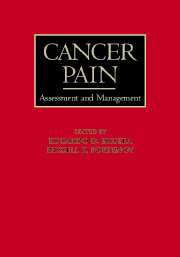Book contents
- Frontmatter
- Contents
- List of contributors
- Preface
- SECTION I MECHANISMS AND EPIDEMIOLOGY
- SECTION II ASSESSMENT AND SYNDROMES
- SECTION III PHARMACOLOGICAL TREATMENT
- SECTION IV NONPHARMACOLOGICAL APPROACHES
- SECTION V THE ROLE OF ANTINEOPLASTIC THERAPIES IN PAIN CONTROL
- SECTION VI PAIN IN SPECIAL POPULATIONS
- SECTION VII DIFFICULT PAIN PROBLEMS
- SECTION VIII SPECIAL TOPICS
- 25 Pain in medical illness: ethical foundations
- 26 Understanding clinical trials in pain research
- 27 Legal and regulatory aspects of opioid treatment: the United States experience
- 28 Role of family caregivers in cancer pain management
- Index
27 - Legal and regulatory aspects of opioid treatment: the United States experience
from SECTION VIII - SPECIAL TOPICS
Published online by Cambridge University Press: 08 October 2009
- Frontmatter
- Contents
- List of contributors
- Preface
- SECTION I MECHANISMS AND EPIDEMIOLOGY
- SECTION II ASSESSMENT AND SYNDROMES
- SECTION III PHARMACOLOGICAL TREATMENT
- SECTION IV NONPHARMACOLOGICAL APPROACHES
- SECTION V THE ROLE OF ANTINEOPLASTIC THERAPIES IN PAIN CONTROL
- SECTION VI PAIN IN SPECIAL POPULATIONS
- SECTION VII DIFFICULT PAIN PROBLEMS
- SECTION VIII SPECIAL TOPICS
- 25 Pain in medical illness: ethical foundations
- 26 Understanding clinical trials in pain research
- 27 Legal and regulatory aspects of opioid treatment: the United States experience
- 28 Role of family caregivers in cancer pain management
- Index
Summary
Introduction
Pain is the most common and perhaps the most feared symptom of cancer (1–4). About one third of persons with cancer have pain at the time their disease is diagnosed and more than two thirds with advanced disease have pain (4–7). Almost all pain of cancer can be relieved with currently available pharmacological and non-pharmacological therapies (4–8). Unfortunately, studies carried out over the past 20 years reveal that often these therapies are not used appropriately. As a result, persons with cancer, even those at the end of life, suffer needlessly from pain (4,9–13). Therefore, it is not surprising that a recent survey found that the general public fear being in pain at the end of life more than they fear death (14).
The reasons for undertreatment of pain have also been thoroughly documented over the last 20 years. These include lack of knowledge and inappropriate attitudes among health care professionals, and patients and families, as well as barriers in the health care and regulatory systems (15–18).
If the magnitude of the problem and the reasons for undertreatment have been known for so long, why does the problem still exist? There are no simple answers to that question. Possible solutions are complicated by the fact that myths and misperceptions about pain and its management are pervasive among health care professionals, patients, and families. Furthermore, the Herculean task of removing the barriers to effective pain management has been undertaken by a relatively small, but dedicated core of health care professionals who know that pain can and should be managed, that relief of pain is a basic human right.
- Type
- Chapter
- Information
- Cancer PainAssessment and Management, pp. 456 - 466Publisher: Cambridge University PressPrint publication year: 2003



